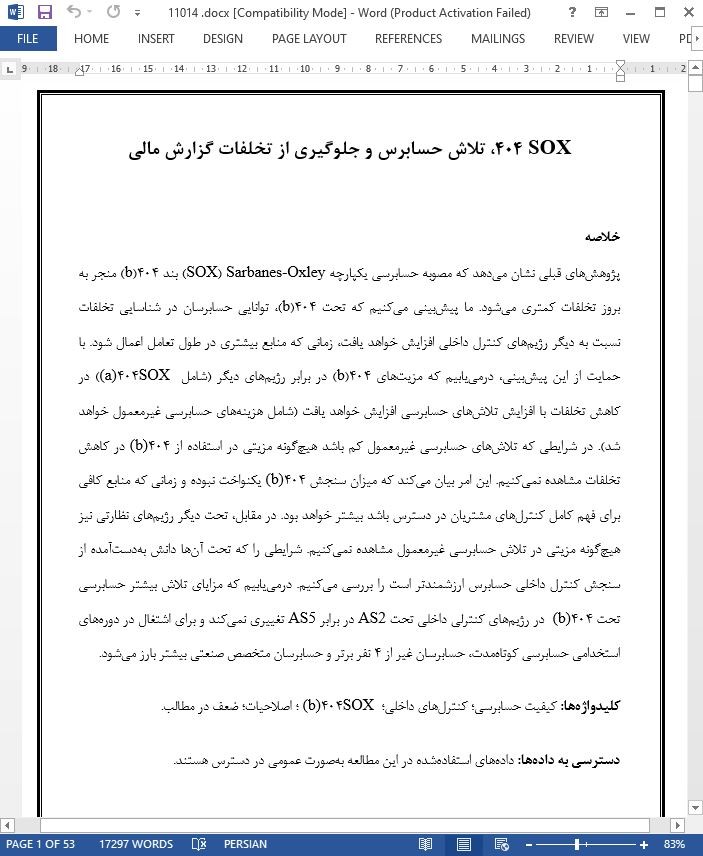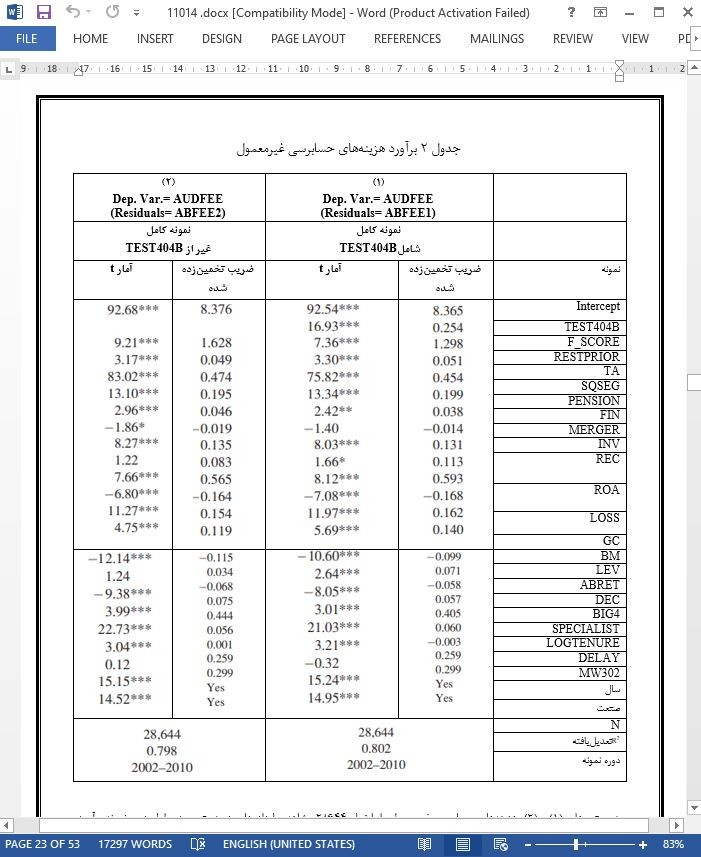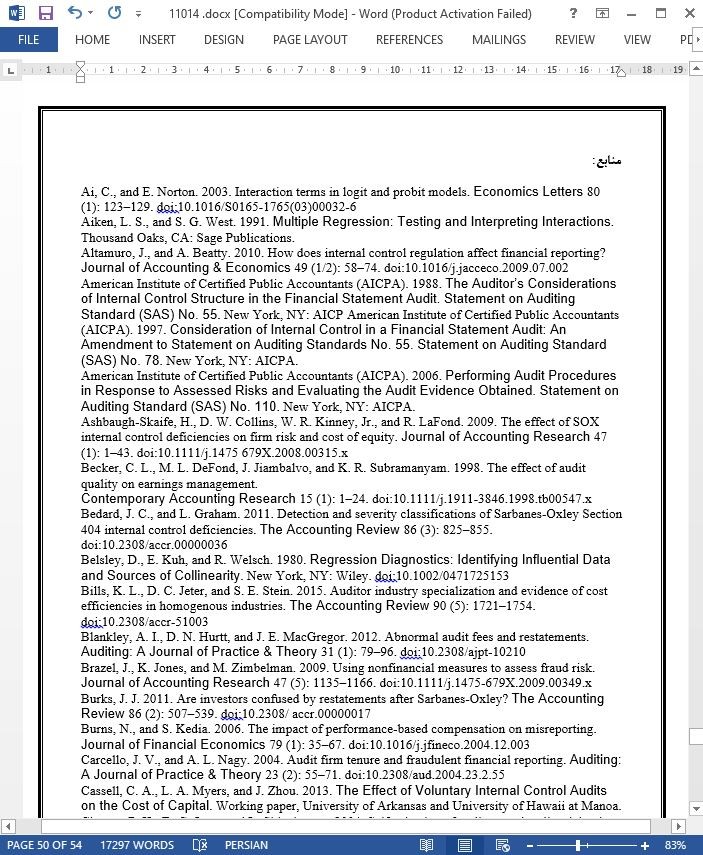
SOX 404، تلاش حسابرس و جلوگیری از تخلفات گزارش مالی
خلاصه
پژوهشهای قبلی نشان میدهد که مصوبه حسابرسی یکپارچه Sarbanes-Oxley (SOX) بند ۴۰۴(b) منجر به بروز تخلفات کمتری میشود. ما پیشبینی میکنیم که تحت ۴۰۴(b)، توانایی حسابرسان در شناسایی تخلفات نسبت به دیگر رژیمهای کنترل داخلی افزایش خواهد یافت، زمانی که منابع بیشتری در طول تعامل اعمال شود. با حمایت از این پیشبینی، درمییابیم که مزیتهای ۴۰۴(b) در برابر رژیمهای دیگر (شامل SOX ۴۰۴(a)) در کاهش تخلفات با افزایش تلاشهای حسابرسی افزایش خواهد یافت (شامل هزینههای حسابرسی غیرمعمول خواهد شد). در شرایطی که تلاشهای حسابرسی غیرمعمول کم باشد هیچگونه مزیتی در استفاده از ۴۰۴(b) در کاهش تخلفات مشاهده نمیکنیم. این امر بیان میکند که میزان سنجش ۴۰۴(b) یکنواخت نبوده و زمانی که منابع کافی برای فهم کامل کنترلهای مشتریان در دسترس باشد بیشتر خواهد بود. در مقابل، تحت دیگر رژیمهای نظارتی نیز هیچگونه مزیتی در تلاش حسابرسی غیرمعمول مشاهده نمیکنیم. شرایطی را که تحت آنها دانش بهدستآمده از سنجش کنترل داخلی حسابرس ارزشمندتر است را بررسی میکنیم. درمییابیم که مزایای تلاش بیشتر حسابرسی تحت ۴۰۴ (b) در رژیمهای کنترلی داخلی تحت AS2 در برابر AS5 تغییری نمیکند و برای اشتغال در دورههای استخدامی حسابرسی کوتاهمدت، حسابرسان غیر از 4 نفر برتر و حسابرسان متخصص صنعتی بیشتر بارز میشود.
مقدمه
تأثیرگذاری بند ۴۰۴ (b) مصوبه Sarbanes-Oxley (SOX، مجلس نمایندگان ایالاتمتحده 2002) را در کاهش تخلفات مالی برحسب تلاش حسابرس و شرایطی را که تحت آنها تلاش بیشتر حسابرسی مزایای بهکارگیری ۴۰۴ (b) را در شناسایی/جلوگیری از تخلفات افزایش میدهد را بررسی میکنیم. SOX مقررات بسیاری را برای کمک به احیای اعتماد سرمایهگذار در گزارش مالی شرکت در نظر گرفته است. در میان این مقررات میتوان به SOX ۴۰۴ اشاره کرد که بهمنظور بهبود کیفی گزارشات مالی با لزوم ارزیابی کنترلهای داخلی بر گزارشنویسی مالی توسط مدیریت (SOX ۴۰۴ (a) و حسابرسان SOX ۴۰۴ (b)) ، همچنین افشای ضعفهای کنترلی را ارائهشده که میتواند باعث تخلف در گزارشات مالی طراحیشده شود. بند ۴۰۴ (b)، بهعنوان یکی از پرهزینهترین و بحثبرانگیزترین مفاد SOX، این مفاد متمرکز بر چندین مطالعه حول سنجش تأثیرگذاری بودهاند . بهطور ویژه در ارتباط با بررسیهای ما، ناگی (2010) احتمال تخلف کمتری را برای شرکتهای تحت SOX ۴۰۴ (b) در سال بعد از پیادهسازی این طرح دریافت میکند. درحالیکه این مطالعه تأثیرات گستردهای را پیدا میکند، مشخص نیست آیا سنجش کنترلی تحت ۴۰۴ (b) میتواند بهصورت یکنواخت به تمام شرکتها سود برساند یا خیر. این مسئله مفاهیم بسیار مهمی برای سرمایهگذاران در سنجش میزان اعتماد به گزارشات مالی و همچنین برای ناظرین در ارزیابی مزیتها نسبت به هزینههای این قانون کلیدی در بردارد.
نتیجهگیری
بیش از 10 سال بعد از مصوب شدن SOX، هنوز مشخص نیست آیا سنجش کنترل داخلی حسابرسان تحت 404(b) به کیفیت گزارشنویسی مالی بهتری نسبت به رژیمهای کنترل داخلی کمکی با هزینهای کمتر منجر میشود یا خیر، به اینکه اگر اینگونه است، تحت چه شرایطی پیشرفتهای گزارشنویسی مالی به دست میآیند. ما بیان میکنیم که پیشرفتی گزارشنویسی مالی از سنجش کنترل تحت 404(b) باید با تلاش حسابرس افزایش یابد. همچنین بیان میکنیم که مزیتهای تلاش بیشتر تحت 404(b) یکنواخت نیستند، بلکه در شرایطی که در آن دانش حسابرس از ساختار کنترل مشتریان بتواند بهتر دریافت شده و استفاده شود، بیشتر خواهد بود. این موضوع را در حوزه جلوگیری از تخلفات گزارشنویسی مالی توسط حسابرسان بررسی میکنیم، چراکه سهامداران از زیانهای قابلتوجهی به لحاظ اصلاحات آسیب میبینند (پالم رز و همکاران 2004؛ هنس، لئون و میلر 2008؛ بورکز 2011). بر این منظور، بر مبنای تحقیق قبلی توسط ناگی (2010) عمل میکنیم، کسی که دریافت سنجش کنترل 404(b) در حالت متوسط تخلفات مالی را در سال بعد از پیادهسازی این رژیم کاهش داده است.
SUMMARY
Prior research shows that the Sarbanes-Oxley Act (SOX) Section 404(b) integrated audit is associated with a lower incidence of misstatements. We predict that under 404(b), the auditor’s ability to detect misstatements increases relative to other internal control regimes when greater resources are exerted during the engagement. Supporting this prediction, we find that the benefits of 404(b) versus other regimes (including SOX 404(a)) in reducing misstatements increase with incremental audit effort (proxied by abnormal audit fees). We find no benefit of 404(b) in misstatement reduction when abnormal audit effort is low. This implies that the value of 404(b) testing is not uniform, but rather is greater when sufficient resources are available to thoroughly understand client controls. In contrast, we find no benefit of abnormal audit effort under other regulatory regimes. We further examine the conditions under which knowledge gained from auditor internal control testing is more valuable. We find that the benefits of increased audit effort under 404(b) do not vary across internal control regimes under AS2 versus AS5, and are more pronounced for engagements with shorter auditor tenure, non-Big 4 auditors, and industry-specialist auditors.
INTRODUCTION
We examine whether the effectiveness of Section 404(b) of the Sarbanes-Oxley Act (SOX, U.S. House of Representatives 2002) in reducing financial misstatements varies with auditor effort, and the circumstances under which greater audit effort enhances the benefits of 404(b) in misstatement prevention/detection. SOX contains many provisions intended to help restore investor confidence in corporate financial reporting. Among these is SOX 404, designed to improve the quality of financial reports by requiring evaluation by management (SOX 404(a)) and auditors (SOX 404(b)) of internal controls over financial reporting, as well as disclosure of control weaknesses that might allow material misstatements in the financial reports. As one of the most costly and controversial provisions of SOX, Section 404(b) had been the focus of a number of studies assessing its effectiveness.1 Particularly relevant to our investigation, Nagy (2010) finds lower misstatement likelihood for firms under SOX 404(b) in the year following implementation. While that study finds a marketwide effect, it is not clear whether control testing under 404(b) uniformly benefits all firms. This issue has important implications for investors in assessing reliability of financial reports, as well as for regulators in measuring benefits relative to costs of this key regulation.
CONCLUSIONS
More than ten years after the passage of SOX, it remains unclear whether auditor internal control testing under 404(b) leads to better financial reporting quality relative to less-costly alternative internal control regimes and, if so, under what circumstances financial reporting improvements are garnered. We propose that the financial reporting improvements arising from control testing under 404(b) should increase with auditor effort. We further suggest that the benefits of greater effort under 404(b) are not uniform, but rather are greater under conditions where auditors’ knowledge of the client’s control structure can be better acquired and used. We investigate this issue in the context of auditors’ prevention of financial reporting misstatements, as shareholders suffer significant losses from restatements (Palmrose et al. 2004; Hennes, Leone, and Miller 2008; Burks 2011). In so doing, we build on prior research by Nagy (2010), who finds that 404(b) control testing on average reduced financial misstatements in the year following implementation of this regime.
1. خلاصه
2. مقدمه
3. پیشینه و برقراری فرضیات
4. پیشینه
5. ایجاد فرضیات
6. SOX ۴۰۴(b) در برابر دیگر رژیمها
7. ارزش متغیر دانش مستمر کنترلهای مشتری تحت SOX ۴۰۴(b)
8. تغییرات در استانداردهای حسابرسی: AS2 در برابر AS5
9. تغییر در توانایی حسابرس در استفاده از تستهای کنترل برای شناسایی حوزههای ریسکی
10. روشها
11. ایجاد نمونه
12. ارزیابی هزینههای حسابرسی غیرمعمول
13. نتایج
14. آمار توصیفی
15. تحلیلهای بیشتر
16. تستهای قابلیت اعتماد
17. متغیرهای حذفشده مرتبط
18. تعاریف کمکی
19. ترکیب نمونه
20. دیگر مسائل طراحی تحقیق
21. نتیجهگیری
1. SUMMARY
2. INTRODUCTION
3. BACKGROUND AND HYPOTHESES DEVELOPMENT
4. Background
5. Hypotheses Development
6. SOX 404(b) versus Other Regimes
7. Differential Value of Incremental Knowledge of Client Controls under SOX 404(b)
8. Variation in Auditing Standards: AS2 versus AS5
9. Variation in the Auditor’s Ability to Use Tests of Controls to Identify Risky Areas
10. METHODS
11. Sample Development
12. Empirical Models and Variables
13. Estimation of Abnormal Audit Fees
14. RESULTS
15. Descriptive Statistics
16. Additional Analyses
17. Robustness Tests
18. Alternative Explanations
19. Sample Composition
20. Other Research Design Issues
21. CONCLUSIONS
- ترجمه فارسی مقاله با فرمت ورد (word) با قابلیت ویرایش، بدون آرم سایت ای ترجمه
- ترجمه فارسی مقاله با فرمت pdf، بدون آرم سایت ای ترجمه



